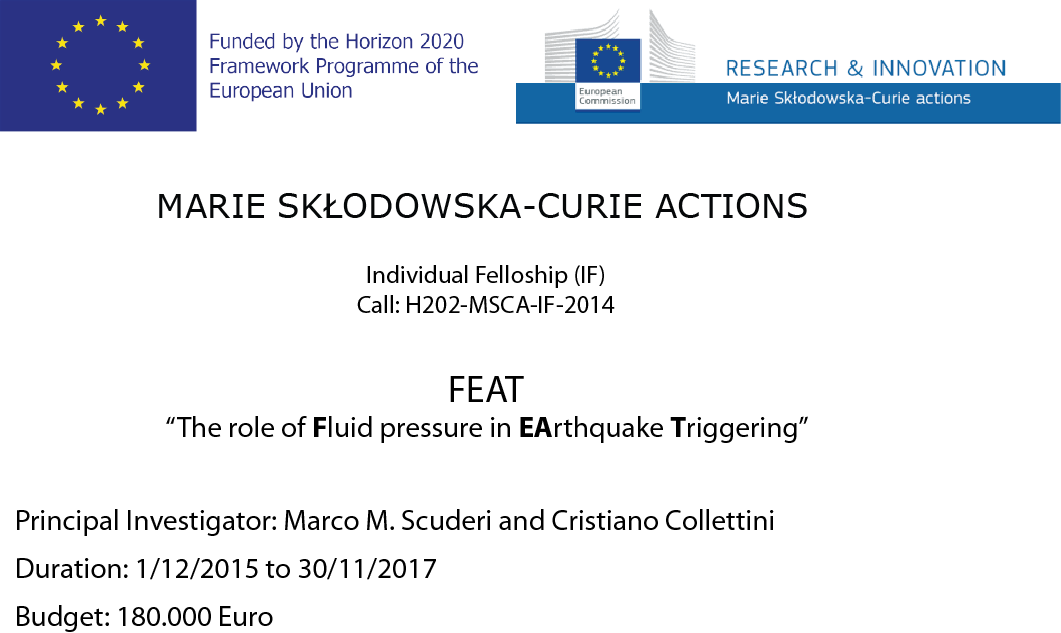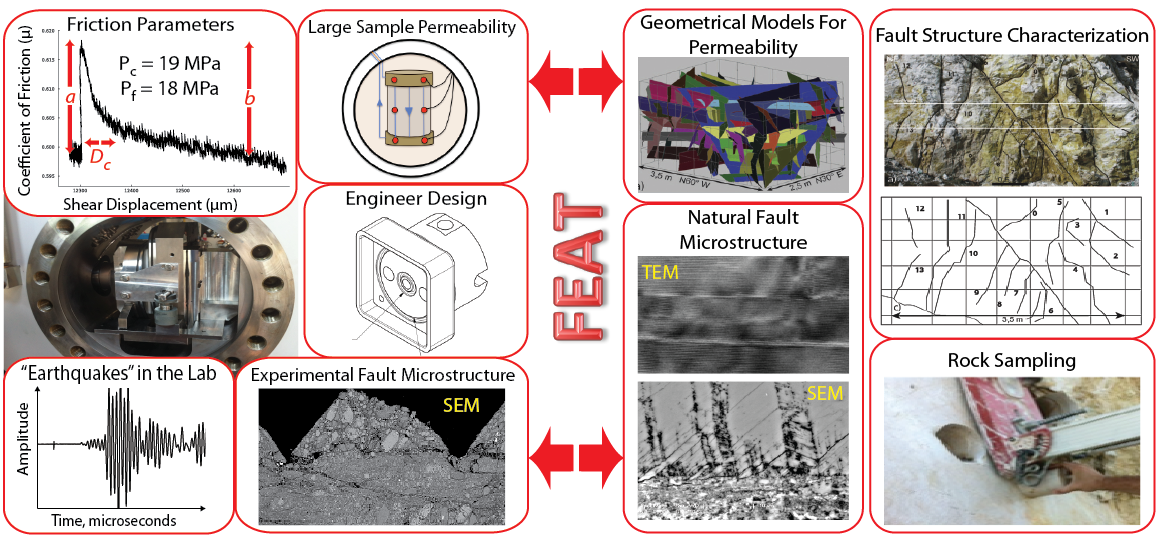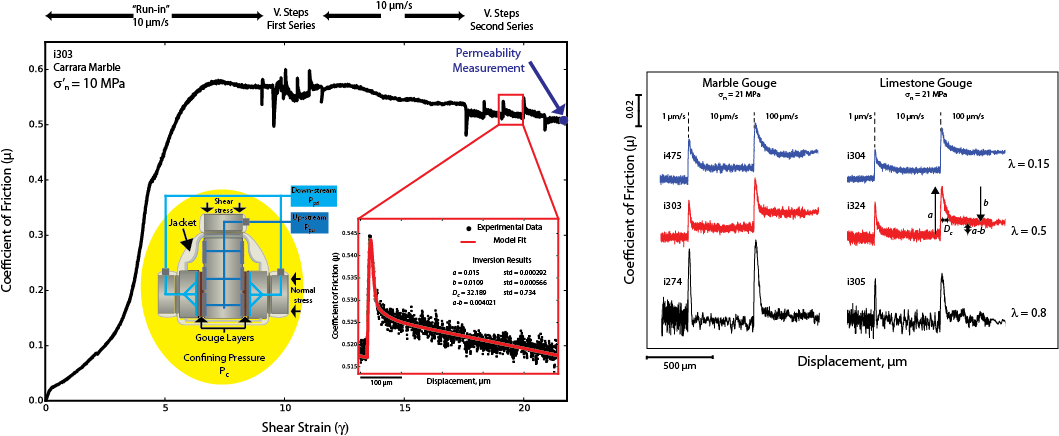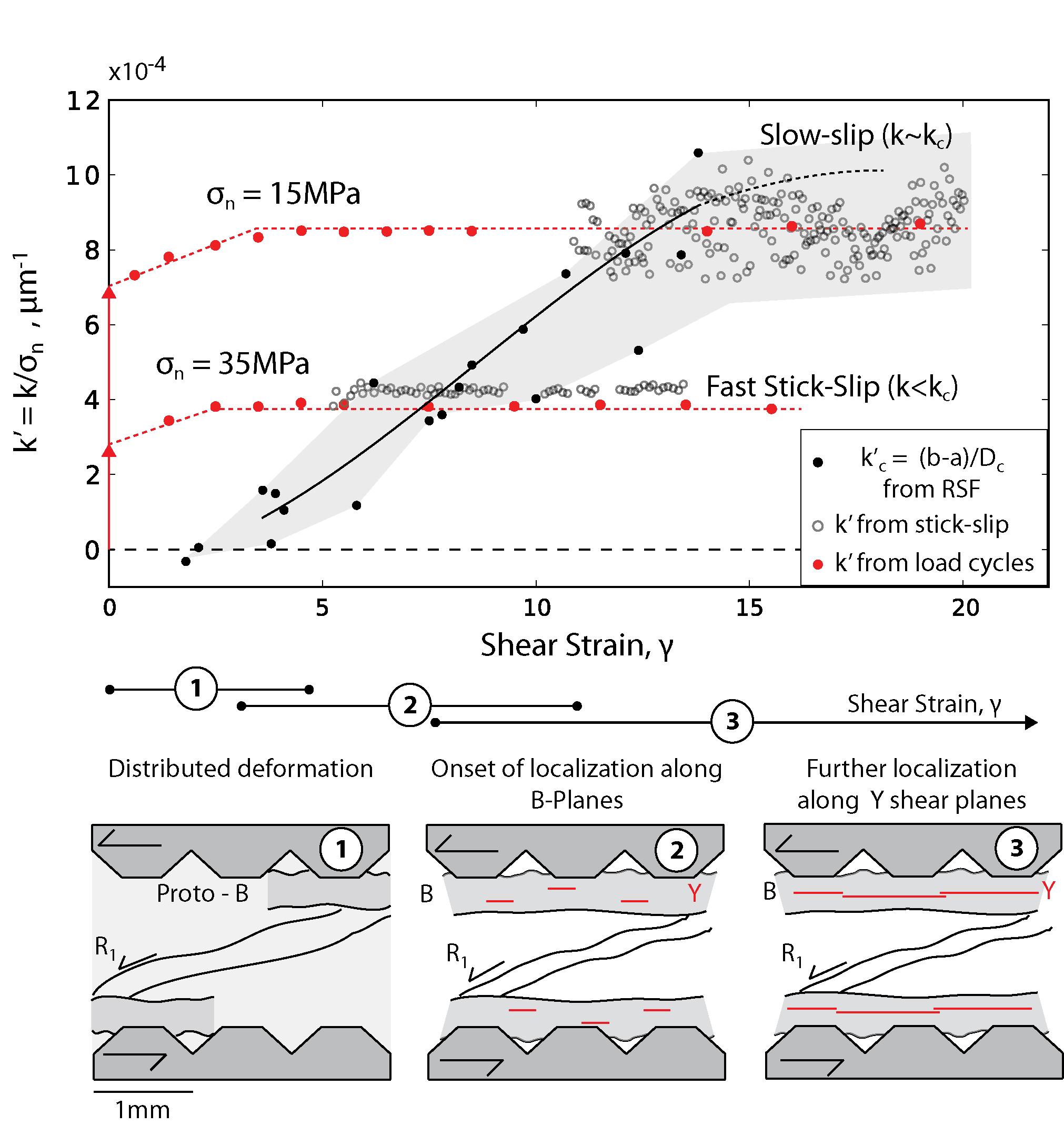
Synoptic view of FEAT
Fluid overpressure has been proposed as one of the primary mechanisms that facilitate earthquake slip along tectonic faults.1,2,3,4 This mechanism is appealing because fluids lubricate the fault and fluid pressure reduces the effective normal stress that clamps the fault in place. However, elastic dislocation theory combined with friction laws suggests that fluid overpressure may inhibit the dynamic instabilities that result in earthquakes.5,6,7 Indeed, for a fault at critical elastic stiffness, a reduction in the effective normal stress tends to promote stable, aseismic slip rather than dynamic earthquake rupture.
This controversy poses a serious problem in our understanding of earthquake physics, with severe implications for both natural and human-induced seismic hazard. In particular, it is important to understand the role of fluid pressure in induced seismicity associated with fluid injection in Earth’s crust, reservoir impoundment, withdrawal of fluids and gas from the subsurface, and for a range of related societal concerns.8,9,10 Nevertheless, currently, there are only a few systematic studies of the role of fluid pressure under controlled, laboratory conditions for which the evolution of friction parameters and slip stability can be deduced.

1 Hubbert, K.M., and Rubey, W.W. (1959). Role of fluid pressure in mechanics of over- trusting faulting. Bull. Geol. Soc. Am. Vol. 70, pp. 115–166.
2 Nur, A., and Booker J. R. (1972). Aftershocks caused by pore fluid flow? Science, Vol. 175, pp. 885-887
3 Sibson, R. (1981). Controls on low-stress hydro-fracture dilatancy in thrust, wrench and normal fault terrains. Nature, Vol. 289, pp. 665–667.
4 Miller, S.A., Collettini, C., Chiaraluce, L., Cocco, M., Barchi, M.R., and Kaus, B., (2004). Aftershocks driven by a high pressure CO2 source at depth. Nature, Vol. 427, pp. 724–727
5 Scholz, C. (1998). Earthquakes and friction laws. Nature, Vol. 391, pp. 37–42.
6 Beeler, N. M., Tullis, T. E., Kronenberg, A.K., & Reinen, L.A. (2007). The instantaneous rate dependence in low temperature laboratory rock friction and rock deformation experiments. Journal of Geophysical Research, doi:10.1029/2005JB003772
7 Ikari, M. J., Marone, C., Saffer, D. M., and Kopf, A.J. (2013). Slip weakening as a mechanism for slow earthquakes. Nature Geoscience, doi:10.1038/ngeo1818
8 Zoback, M., Kohli, A., Das, I. and Mcclure, M.W. (2012). The importance of slow slip on faults during hydraulic fracturing stimulation of shale gas reservoirs. Society of Petroleum Engineers. doi:10.2118/155476-MS
9 Ellsworth, W. L. (2013). Injection-induced earthquakes. Science, doi:10.1785/gssrl.83.2.250
10 Keranen, K., M. Weingarten, and G. Abers (2014), Sharp increase in central Oklahoma seismicity since 2008 induced by massive wastewater injection, Science, doi:10.1038/45144.
The role of fluid pressure in frictional stability and earthquake triggering: insights from rock deformation experiments on carbonates
Scuderi M.M. and Collettini C., Nature Scientific Report (2016)
Here, we use laboratory experiments, to show that the rate- and state- friction parameters do change with increasing fluid pressure. We tested carbonate gouges from sub hydrostatic to near lithostatic fluid pressure conditions, and show that the friction rate parameter (a-b) evolves from velocity strengthening to velocity neutral behaviour. Furthermore, the critical slip distance, Dc, decreases from about 90 to 10 μm. Our data suggest that fluid overpressure plays an important role in controlling the mode of fault slip. Since fault rheology and fault stability parameters change with fluid pressure, we suggest that a comprehensive characterization of these parameters is fundamental for better assessing the role of fluid pressure in natural and human induced earthquakes.

Frictional stability and earthquake triggering during fluid pressure stimulation of an experimental fault
Scuderi M.M., Marone C. and Collettini C. Earth and Planetary Science Letters (2017)
It is widely recognized that the significant increase of M > 3.0 earthquakes in Western Canada and the Central United States is related to underground fluid injection. Following injection, fluid overpressure lubricates the fault and reduces the effective normal stress that holds the fault in place, promoting slip. Although, this basic physical mechanism for earthquake triggering and fault slip is well understood, there are many open questions related to induced seismicity. Models of earthquake nucleation based on rate- and state- friction predict that fluid overpressure should stabilize fault slip rather than trigger earthquakes. To address this controversy, we conducted laboratory creep experiments to monitor fault slip evolution at constant shear stress while the effective normal stress was systematically reduced via increasing fluid pressure. We sheared layers of carbonate-bearing fault gouge in a double direct shear configuration within a true-triaxial pressure vessel. We show that fault slip evolution is controlled by the stress state acting on the fault and that fluid pressurization can trigger dynamic instability even in cases of rate strengthening friction, which should favor aseismic creep. During fluid pressurization, when shear and effective normal stresses reach the failure condition, accelerated creep occurs in association with fault dilation; further pressurization leads to an exponential acceleration with fault compaction and slip localization. Our work indicates that fault weakening induced by fluid pressurization can overcome rate strengthening friction resulting in fast acceleration and earthquake slip. Our work points to modifications of the standard model for earthquake nucleation to account for the effect of fluid overpressure and to accurately predict the seismic risk associated with fluid injection.

Seismic velocity changes reveal precursors for the spectrum of earthquake failure modes
M.M. Scuderi, C. Marone, E. Tinti, G. Di Stefano and C. Collettini, Nature Geoscience (2016)
Temporal changes in seismic velocity during the earthquake cycle have the potential to illuminate physical processes associated with fault weakening and connections between the range of fault slip behaviors including slow earthquakes, tremor and low frequency earthquakes1. Laboratory and theoretical studies predict changes in seismic velocity prior to earthquake failure2, however tectonic faults fail in a spectrum of modes and little is known about precursors for those modes3. Here we show that precursory changes of wave speed occur in laboratory faults for the complete spectrum of failure modes observed for tectonic faults. We find systematic variations of elastic properties during the seismic cycle for both slow and fast earthquakes indicating similar physical mechanisms during rupture nucleation. Our data show that accelerated fault creep causes reduction of seismic velocity and elastic moduli during the preparatory phase preceding failure, which suggests that real time monitoring of active faults may be a means to detect earthquake precursors.

Evolution of Shear Fabric in Granular Fault Gouge From Stable Sliding to Stick-Slip and Implications for Fault Slip Mode
M.M. Scuderi, C. Collettini, C. Viti, E. Tinti and C. Marone, Geology (2017)
Laboratory and theoretical studies provide insight into the mechanisms that control earthquake nucleation, when fault slip velocity is slow (<0.001 cm/s), and dynamic rupture when fault slip rates exceed cm/s. The application of these results to tectonic faults requires information about fabric evolution with shear and its affect on the mode of faulting. Here we report on laboratory experiments that illuminate the evolution of shear fabric and its role in controlling the transition from stable sliding (v~0.001 cm/s) to dynamic stick-slip (v>1 cm/s). The full range of fault slip modes was achieved by controlling the ratio, K = k/kc, where k is the elastic loading stiffness, and kc is the fault zone critical rheologic stiffness. We show that K controls the transition from slow-and-silent slip (K > 0.9) to fast-and-audible (K < 0.7, v = 3 cm/s, slip duration 0.003 s) slip events. Microstructural observations show that with accumulated strain, deformation concentrates in shear zones containing sharp shear planes made of nano-scale grains, which favour the development of frictional instabilities. Once this fabric is established, fault fabric does not change significantly with slip velocity, and fault slip behaviour is mainly controlled by the interplay between the rheological properties of the slipping planes and fault zone stiffness. As applied to tectonic faults, our results suggest that a single fault segment can experience a spectrum of fault slip behaviour depending on the evolution of fault rock frictional properties and viscoelastic properties of the wall rock surrounding the fault.








